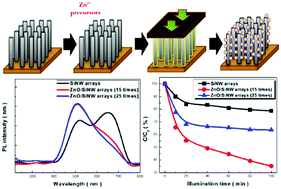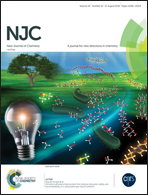Solution-processed ZnO/Si based heterostructures with enhanced photocatalytic performance†
Abstract
Although hybrid semiconductor nanostructures have shown high potential for optoelectronic applications, great challenges remain owing to the fabrication difficulties of nanoscale heterostructures with sound uniformity based on a solution synthesis. In this study, a facile, large-area and reliable solution-processed deposition was employed, which enabled uniform fabrication of ZnO nanoparticles on silicon nanowire (SiNW) arrays with a high aspect ratio. This was accomplished by the introduction of shear stress at glass/SiNW contacts during baking treatment, which dramatically enforced the lateral migration of Zn2+-containing solutions for nucleation and effectively reduced the expected aggregation at the SiNW tips, forming well-incorporated ZnO/SiNW arrays. Chemical compositions, crystallographic characteristics and photoluminescence analysis were performed to examine the hybrid heterostructures, indicating wide-band absorption capability of light from ultraviolet to visible regions. Furthermore, photocurrent investigations revealed the efficient charge separation of photogenerated electrons and holes, owing to the heterojunction created which reduces the direct charge recombination. Based on these features, the large-area, highly light-absorptive ZnO/SiNW heterostructures possess improved photocatalytic activity for the degradation of organic dyes, and further present sound reliability with retained photodegradation efficiency for cycling use.



 Please wait while we load your content...
Please wait while we load your content...